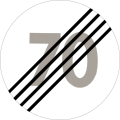This article needs additional citations for verification .(August 2016) |

Norway has two general speed limits:
- 50 km/h in densely populated areas.
- 80 km/h in sparsely populated areas.
General speed limits in Norway are not signposted, except in certain circumstances, and shall be indicated by the road's surroundings. Other speed limits are referred to as special speeds limits. These are signposted. The general speed limits are signposted when the general speed limit is lower than the speed limit one is coming from. [1]
Contents
Special speed limits range from 10 km/h to 110 km/h. The most common being 30 km/h in residential areas, 50 km/h and 60 km/h in urban areas, and 70 km/h and above on rural roads/motorways. 80 km/h is by far the most common speed limit. 90 km/h is found on good 2-lane roads with few intersections and sparse traffic, and 100 km/h and 110 km/h on motorways.
Some vehicles and driving licenses have additional restrictions. These include:
- Vehicles weighing over 3500 kg or vehicles pulling trailers may not drive faster than 80 km/h.
- Except buses, which may drive up to 100 km/h.
- Vehicles pulling "Tempo 100" approved trailers may drive up to 100 km/h. [2]
- Driving licence class T gives the right to drive tractors with a top speed of up to 40 km/h.
- Driving licence class AM (moped licence) gives the right to drive moped with a top speed of up to 45 km/h.







